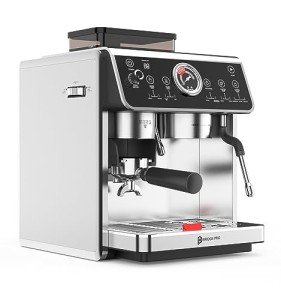The Rise of Black Espresso Machines: Features, Benefits, and Recommendations
Espresso machines have actually ended up being a necessary home appliance in numerous households and cafés, evolving from a specialized product to a basic kitchen fixture. Among Professional Espresso Machines and styles offered, black espresso machines are leading the pack in regards to looks, adaptability, and consumer preference. In this post, we look into the reasons behind their appeal, the features that set these machines apart, and helpful ideas for selecting the perfect black espresso machine for your home.
The Appeal of Black Espresso Machines
Visual Versatility
Black espresso machines effortlessly blend into any cooking area décor. Whether your cooking area boasts modern, minimalist styles or standard, cozy aesthetic appeals, a black espresso machine matches the environment without clashing with other home appliances. The sleek finish contributes to a refined look, including a touch of sophistication to your countertop.
Easier Maintenance
Unlike lighter-colored machines that may reveal stains, smudges, and water spots more readily, black espresso machines tend to resist noticeable wear and tear. This not only makes them more aesthetically appealing with time but also lowers the frequency of cleansing needed.
Broad Market Availability
The appeal of black espresso machines has actually led to a broader range of designs, functions, and rate points. Customers have the benefit of picking from compact home machines to commercial-grade systems, guaranteeing that there is something for everyone.
Key Features to Consider
When looking for a black espresso machine, it is important to consider different features that affect efficiency and ease of use. Below are some of the most important features to search for:
1. Kind Of Espresso Machine
There are a number of types of espresso machines that accommodate various ability levels:
- Manual: Requires the user to have accurate abilities and is ideal for enthusiasts trying to find full control over the espresso-making procedure.
- Semi-Automatic: Offers a balance in between control and benefit. Users can control the extraction time however benefit from the machine's automatic pressure guideline.
- Automatic: Takes care of the water dose, making it ideal for those who want constant outcomes with very little effort.
- Super-Automatic: The most user-friendly type, these machines grind beans, tamp coffee, and brew the espresso with just the push of a button.
2. Building Material
Quality building products, such as stainless-steel or state-of-the-art plastic, ensure durability and performance. Machines with all-metal bodies often have better longevity and visual appeal.
3. Size and Capacity
Before acquiring, consider kitchen area space and the machine's capacity. If you're amusing frequently or serve espresso to multiple visitors, bigger water tanks and bean hoppers are beneficial.
4. Reduce of Use and Features
Look for features that boost the user experience:
- Programmable Settings: permits modification of your developing process.
- Steam Wand: vital for frothing milk for cappuccinos and lattes.
- Built-in Grinder: decreases the requirement for additional devices and offers fresh premises.
- Water Filtration System: improves water quality, impacting the taste of the espresso.
5. Cost Range
Rates for black espresso machines can differ widely. Budget designs may vary from ₤ 100 to ₤ 300, while mid-range machines fall in between ₤ 300 and ₤ 800. For commercial-grade or innovative super-automatic machines, expect to invest ₤ 800 and up.
Table: Price Range of Black Espresso Machines
| Type of Machine | Price Range | Key Features |
|---|---|---|
| Budget Manual | ₤ 100 - ₤ 300 | Standard performance, manual operation |
| Mid-Range Semi-Automatic | ₤ 300 - ₤ 800 | Programmable settings, steam wand |
| Super-Automatic | ₤ 800 and up | Full automation, integrated grinder |
| Commercial Grade | ₤ 1,000 and above | High capability, resilient building |
Advantages of Owning a Black Espresso Machine
1. Quality of Espresso
The main function of an espresso machine is to brew high-quality espresso. A good black espresso machine can use abundant tastes and a fragrant experience.
2. Cost-efficient
Buying an espresso machine enables users to develop café-quality beverages in the house, saving cash in the long run.
3. Convenience
Enjoying fresh espresso from the comfort of home decreases journeys to coffee stores, providing convenience especially for hectic people.
4. Personalization
Home baristas can experiment with various coffee beans, grind settings, and temperature levels to find their ideal cup.
Often Asked Questions (FAQs)
Q1: What are the very best black espresso machines on the market?
Some premier black espresso machines consist of the Breville Barista Express, De'Longhi Magnifica, and Rancilio Silvia, each offering a balance of quality and use.
Q2: How do I preserve my black espresso machine?
Routine maintenance consists of cleaning up the machine after use, descaling every few months, and regularly checking and replacing water filters.
Q3: Can I make drinks besides espresso with these machines?
Yes, lots of espresso machines feature steam wands, allowing you to develop cappuccinos, lattes, and other coffee drinks.
Q4: What size should I select for my kitchen?
Select a machine based upon your countertop area and the volume of coffee you normally brew, thinking about both water tank size and total measurements.
Q5: Are black espresso machines more pricey?
Not necessarily; while some high-end designs are black, there are affordable alternatives offered in this color range.
Black espresso machines are not simply a pattern; they embody performance, style, and flexibility. Whether you are a coffee connoisseur or a casual drinker, these machines use something for everybody. By carefully considering functions, investing in quality, and selecting the ideal type, coffee lovers can enjoy the many benefits of developing espresso in the house in style. The appeal of black espresso machines will likely continue to grow, making them a staple in cooking areas worldwide.

